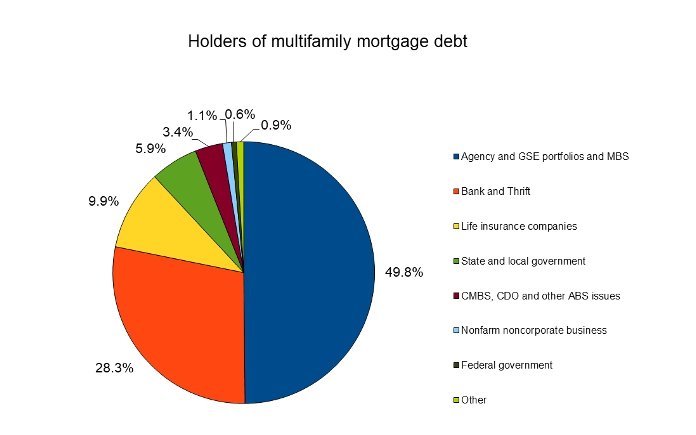A Mortgage Bankers Association (MBA) report on commercial and multifamily mortgage debt shows that banks and thrifts had the largest net increase in multifamily mortgage holdings in Q4 2021. However, the GSEs continued to have the largest share of multifamily mortgages outstanding.
The MBA reported that multifamily mortgage debt outstanding rose by $42.1 billion in Q4, an increase of 2.4 percent. Total multifamily mortgage holdings reached a level of $1.810 trillion. Compared to the year-earlier level, this debt was up $122 billion (7.2 percent).
The total of all commercial mortgage debt, including multifamily debt, outstanding at the end of Q4 rose 2.9 percent from its Q3 level to $4.161 trillion. Multifamily mortgage debt represented 43.5 percent of commercial mortgage debt outstanding.
Earlier, the MBA had reported that multifamily mortgage originations had increased significantly in Q4, with the Q4 2021 multifamily mortgage originations index reported to be 2.7 times the level of the index in Q1 2021. By contrast, the increases in multifamily mortgage debt outstanding in Q4 was only 1.4 times that of the increase in Q1. This implies that, while mortgage originations increased over the course of the year, mortgage redemptions must have increased also. However, the level of mortgage redemptions is not covered in either of the MBA reports.
Dividing the market
The shares of multifamily mortgage debt held by various classes of suppliers are shown in the first chart, below.

Of the increase in multifamily mortgage debt outstanding in the quarter, $16.0 billion, was held by “Agency and GSE portfolios and MBS”. These are agencies, like the Federal Housing Administration and Government Sponsored Enterprises (GSEs) like Fannie Mae and Freddie Mac, who buy up mortgages and sell some of the debt as Mortgage-Backed Securities (MBS). At the end of Q4, the GSEs holdings fell to 49.8 percent of the total outstanding.
Banks and Thrifts, the second largest holders of multifamily mortgages, increased their multifamily mortgage holdings by $16.5 billion during Q4. This increased their share of outstanding multifamily mortgage debt to 28.3 percent.
Life Insurance companies increased their direct holding of multifamily mortgage holdings by $1.96 billion in the quarter, raising their holdings to $179.4 billion. However, their share of total multifamily mortgage debt outstanding fell slightly to 9.9 percent in the quarter. It should be noted that this figure does not account for the debt these companies hold through commercial mortgage-backed securities (CMBS).
State and local governments held 5.9 percent of outstanding multifamily mortgage debt at the end of Q4. Their holdings totaled $106.1 billion at the end of the quarter.
CMBS, CDO (collateralized debt obligations) and other ABS (asset backed securities) issues increased their holdings of multifamily mortgage debt in Q4 by $7.1 billion. Their share of debt outstanding rose to 3.4 percent.
REITs are not a major holder of multifamily mortgage debt with a 0.5 percent share, but they have been increasing their holdings at a rapid rate in recent quarters. They added $931 million to their holding in Q4.
Tracking shares
The next chart, which is adapted from the MBA report, shows how the multifamily mortgage holdings of the major classes of issuers have changed over time. It shows that the mortgage holdings of banks and thrifts barely grew in the years after the housing crash while the share of CMBS and CDO’s fell significantly. After the pandemic started in early 2020, the GSE’s stepped in to hold an increasing share of multifamily mortgages. Recently, Banks have been increasing their share of mortgage holdings.

The report does not cover loans for acquisition, development or construction, or loans collateralized by owner-occupied commercial properties. The full report also includes information on mortgage debt outstanding for other commercial property types. The full report can be found here.













